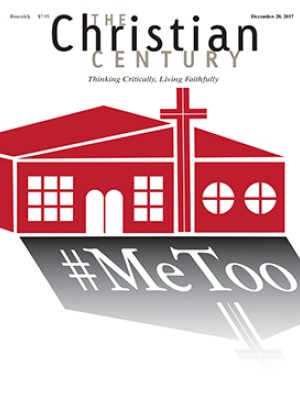The mortgage interest deduction subsidizes housing for people who don't need the help
The House tax bill would cap the benefit—a solid idea in a bill that doesn't offer many.
In January, not long after my wife began her first parish ministry job, she and I became home owners. Around early April or so I realized that my days of throwing together our tax return while watching a baseball game are probably over. Along with the complication of following tax rules for clergy, we now have a compelling reason to itemize our deductions: the mortgage interest deduction, also known as the most significant way the federal government subsidizes housing.
In November, House Republicans passed a tax-reform bill. For the most part, it reads like a parody of GOP orthodoxy: deep tax cuts for both corporations and private businesses, a higher income threshold for the top individual rate, full repeal of the estate tax. The bill declines to close an income tax loophole for finance workers or to restrict conservation easements so they stop going to golf course developers. It does muster the resolve to crack down on deductions claimed by such notorious freeloaders as student debtors, people with expensive diseases, and teachers who buy their own pencils. (The parallel Senate bill approved on December 2 avoids some of the House version’s worst outrages, substituting others.)
Read our latest issue or browse back issues.
Yet this lousy legislation also includes the odd bit of sound public policy. Exhibit A: the House bill would tighten limits on the mortgage interest deduction, lowering the ceiling on eligible home loans from $1 million to $500,000. Here too there’s plenty to criticize about the politics, starting with the fact that houses worth more than a half million dollars tend to be located in liberal districts (i.e., big metro areas). Still, taken on its own, this is a really good idea.
The MID was created in 1913, a time when far fewer Americans owned their own home and a lot more of the ones who did were farmers with burdensome business loans. Today the affluent almost always own a home (at least one), and 75 percent of MID benefits—which are on track to total more than $96 billion by 2019—go to the 20 percent of households with the highest earnings. Meanwhile, 75 percent of those eligible for low-income housing assistance never get it, because the funding isn’t there.
The MID’s defenders argue that it incentivizes homeownership, but there’s little evidence that it does. The biggest financial barrier to becoming a home owner is the down payment, which the MID doesn’t help with. And while the National Association of Realtors is correct that cutting the MID would lead to “home value destruction,” that’s just a creative way of saying that prices would go down—not exactly a bad thing if you’re thinking about buying your first home. The MID inflates the market, which prevents low-income renters from buying (and may also drive up their rent in the meantime). Once you do make the jump to homeownership, the MID only helps you if you spend enough on mortgage interest and other deductible expenses to justify itemizing your deductions. Lower-income home owners generally do not.
Here’s what the MID does incentivize: larger, fancier houses for those who are going to buy a house regardless. In isolation, one might see this as a fairly benign effect. As a federal spending priority, however, it’s pretty hard to justify. The MID funnels billions of dollars in housing aid almost entirely to people who don’t really need the help.
In 2013, the National Low Income Housing Coalition organized a campaign to not only cap the MID at $500,000 but also invest the savings in rental housing assistance and convert the remaining MID benefit to a tax credit (so you don’t have to itemize deductions to claim it). No one expects such an ambitious package to be enacted in the current political climate. But really, the MID is so regressive that simply capping it would be a net gain for economic equality, no matter what you did with the extra money.
Well, I guess there’s one thing that would be worse: you could give the savings directly to rich people. Wealth transfer upward is the centerpiece of this tax reform legislation, the purpose everything else serves. If congressional Republicans wanted to include more provisions to help lower-income Americans, there are a lot of ways they could do that. Two GOP senators proposed one good one: making the child tax credit fully refundable, so that even people who don’t earn enough to owe any income tax are eligible for it. The idea didn’t make it into the bill. Neither did many others that would help the people who need it most.
This is, of course, legislation about taxes, not social spending. But that is more of a technical difference than a substantive one. Tax deductions and credits are a form of spending; they’re government programs under another name. When you claim a tax deduction, you’re doing very much the same thing as someone who applies for a federal benefit: money that would otherwise go into the federal coffers is instead directed to you—indeed targeted at you, based on specific criteria defined by policy makers. As a matter of fiscal budgeting, the MID is like any other housing entitlement program—only bigger and aimed mostly at rich people.
The politics, however, are another story. Taxpayers don’t tend to see a tax deduction or credit as a form of government largesse; we see it simply as our own money, to do with as we please. This is how you get a situation in which some rich home owners feel no shame in criticizing government housing programs while themselves benefiting from the biggest such program there is. In the public imagination, tax-code spending simply doesn’t register as spending. This is, of course, one reason so much of it exists. Politicians tend to find it easier to spend money when they get to call it a tax break.
In a saner policy-making world, MID reform wouldn’t be evaluated as a way to pay for tax cuts for the rich or anyone else. It would be weighed against other spending on housing: Whom does the spending help, and who will suffer if it’s cut? In a more functional Congress, the MID would have been downsized or eliminated long ago, because members on both sides of the aisle struggle to defend billions in spending that mostly just gives people who are going to buy a house anyway an incentive to buy a bigger one.
Instead we have the House’s tax-reform effort, a bad bill that also contains this small good thing. To be clear, the House’s MID rollback is a modest one. If it went farther—say, by lowering the ceiling not just to $500,000 but to $250,000 and applying this change to existing mortgages along with new ones—it would affect a lot more families’ taxes. Mine, for instance. And the money saved by this prudent spending cut could be plowed into housing assistance for people who need it far more than I do.
That won’t happen, not now anyway. And it’s far from certain that the current proposal will make it into law. But the fact that this provision found its way into the bill in the first place indicates that lawmakers know the MID is bad public policy. There will be chances in the future to get the legislation right—so that however much the government spends on housing subsidies, at least they’ll be going to people who actually need them.
This article was updated on December 2. A version of the article appears in the December 20 print edition under the title “One good idea in the tax bill.”








